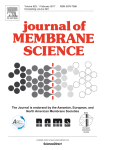 Authors: Kristin DALANE, Hallvard F. SVENDSEN, Magne HILLESTAD, Liyuan DENG
Authors: Kristin DALANE, Hallvard F. SVENDSEN, Magne HILLESTAD, Liyuan DENG
Affiliation: Department of Chemical Engineering, Norwegian University of Science and Technology (NTNU), Sem Sælandsvei 4, N-7491 Trondheim, Norway
Reference (APA): Dalane, K., Svendsen, H. F., Hillestad, M., & Deng, L. (2018). Membrane contactor for subsea natural gas dehydration: Model development and sensitivity study. Journal of Membrane Science, 556, 263–276. https://doi.org/10.1016/j.memsci.2018.03.033
Abstract: “A mathematical model of a membrane contactor using triethylene glycol (TEG) for dehydration of natural gas at subsea operation conditions has been developed. The goal for the membrane contactor is to dehydrate the natural gas to transport pipeline specifications, which are −19 °C at 69 barg. The membrane contactor model is based on a hollow fiber configuration with the gas in the shell side and the liquid absorbent inside the fiber. The shell side gas is modelled as one-dimensional on the assumption of turbulent flow, while the fiber/lumen side is modelled as two-dimensional flow due to the laminar flow. Orthogonal collocation is applied to solve the two-point boundary value problem. The developed model is validated against proprietary high pressure experimental data for dehydration of natural gas with TEG in a membrane contactor. The H2O molar flow removed from the gas phase is predicted by the model with a mean absolute error range of 3–7% compared to the experimental results, based on two methods of calculation due to uncertainty in experimental basis…”
Comments: the authors briefly mention that the mathematical model developed in MATLAB for a membrane contactor is also implemented into Aspen HYSYS with the use of the MATLAB CAPE-OPEN Unit Operation supplied by AmsterCHEM. However the description of the model comprises also the thermodynamic and physical properties aspect so apparently the development of the model did not make use of the MATLAB Thermo Import which is also provided by AmsterCHEM. So the model described cannot be, without a few modifications, wrapped as a CAPE-OPEN Unit Operation that does not contain thermodynamic functions but calls for them through CAPE-OPEN interfaces.
